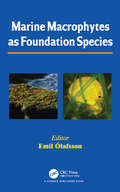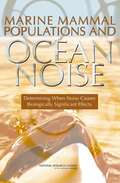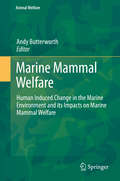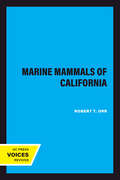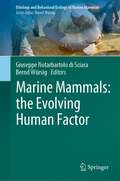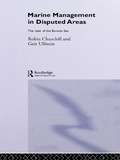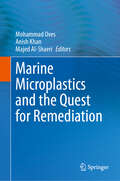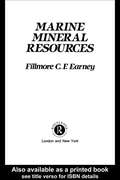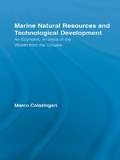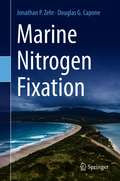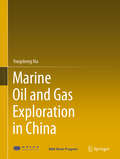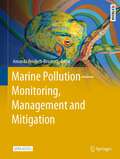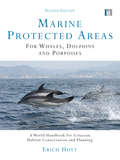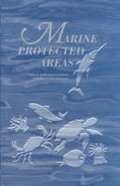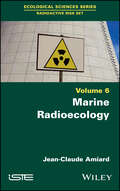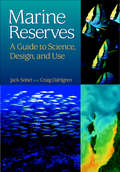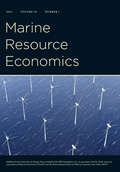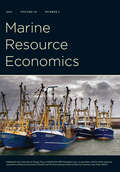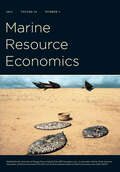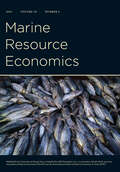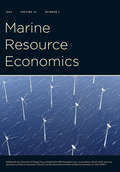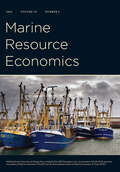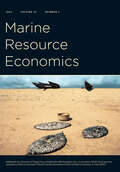- Table View
- List View
Marine Macrophytes as Foundation Species
by Emil OlafssonMarine macrophytes (macroalgae, seagrasses, and mangroves) comprise thousands of species distributed in shallow water areas along the world’s coastlines. They play a key role in marine ecosystems regarding biodiversity and energy flow. A large proportion of macrophyte species can be characterised as ecosystem engineers—organisms that directly or indirectly affect the availability of resources to other species by modifying, maintaining, and creating habitats. <P><P>This book is divided into three main themes: <li>Marine macroalgae and seagrasses as sources of biodiversity gives an overview of the diversity of the main organisms associated with macrophytes, and their functional role and interactions within their hosts. <li> Primary and secondary production of Macrophytes synthesizes research on food web structures derived from/or associated with, macrophytes and the transfer of macrophytic primary and secondary production from one ecosystem to another. <li> Threats to macrophytic ecosystem engineers addresses human-induced effects including eutrophication, physical destruction, invasive species, and global warming. <P><P>The book is among the first one to concentrate on the value of macrophytes for the well-being of marine habitats. The book is aimed at academics but may be useful for students, policy makers, and laymen alike.
Marine Mammal Populations And Ocean Noise: Determining When Noise Causes Biologically Significant Effects
by National Research Council of the National AcademiesAttention has been drawn to the subject of how ocean noise affects marine mammals by a series of marine mammal strandings, lawsuits, and legislative hearings, and most recently, the report from the U.S. Commission on Ocean Policy. One way to assess the impact of ocean noise is to consider whether it causes changes in animal behavior that are "biologically significant," that is, those that affect an animal's ability to grow, survive, and reproduce. This report offers a conceptual model designed to clarify which marine mammal behaviors are biologically significant for conservation purposes. The report is intended to help scientists and policymakers interpret provisions of the federal Marine Mammal Protection Act.
Marine Mammal Welfare
by Andy ButterworthMarine mammals attract human interest – sometimes this interest is benign or positive – whale watching, conservation programmes for whales, seals, otters, and efforts to clear beaches of marine debris are seen as proactive steps to support these animals. However, there are many forces operating to affect adversely the lives of whales, seals, manatees, otters and polar bears – and this book explores how the welfare of marine mammals has been affected and how they have adapted, moved, responded and sometimes suffered as a result of the changing marine and human world around them. Marine mammal welfare addresses the welfare effects of marine debris, of human traffic in the oceans, of noise, of hunting, of whale watching and tourism, and of some of the less obvious impacts on marine mammals – on their social structures, on their behaviours and migration, and also of the effects on captivity for animals kept in zoos and aquaria. There is much to think and talk about – how marine mammals respond in a world dramatically influenced by man, how are their social structures affected and how is their welfare impacted?
Marine Mammals of California (California Natural History Guides #29)
by Robert T. OrrThis title is part of UC Press's Voices Revived program, which commemorates University of California Press’s mission to seek out and cultivate the brightest minds and give them voice, reach, and impact. Drawing on a backlist dating to 1893, Voices Revived makes high-quality, peer-reviewed scholarship accessible once again using print-on-demand technology. This title was originally published in 1972.This title is part of UC Press's Voices Revived program, which commemorates University of California Press’s mission to seek out and cultivate the brightest minds and give them voice, reach, and impact. Drawing on a backlist dating to 1893, Voices Revived</DIV
Marine Mammals: The Evolving Human Factor (Ethology and Behavioral Ecology of Marine Mammals)
by Bernd Würsig Giuseppe Notarbartolo di SciaraThe seventh volume in the series “Ethology and Behavioral Ecology of Marine Mammals” describes aspects of the often-complex relationship between humans and marine mammals. From a primeval condition of occasional predators, during the last century humans have become a major factor negatively affecting the status of most marine mammals through over-hunting, habitat encroachment and environmental degradation. This has led to the extirpation of many marine mammal populations and even to the extinction of species. However, in parallel to this destructive drive, since antiquity humanity has been influenced by a strong fascination for marine mammals, which contributes today to an increased human appreciation of the natural world admixed with widespread concern for its degrading condition. The special status occupied by marine mammals in human imagination and affection stands in stark contrast with the current predicament of many populations still threatened by the doings of Homo sapiens: a condition emblematic of the relationship of humanity with nature, and key to understanding where humanity is heading.
Marine Management in Disputed Areas: The Case of the Barents Sea (Routledge Advances in Maritime Research)
by Geir Ulfstein Robin ChurchillFirst published in 1992. Routledge is an imprint of Taylor & Francis, an informa company.
Marine Microplastics and the Quest for Remediation
by Mohammad Oves Anish Khan Majed Al-ShaeriThis informative book discusses the issue of microplastic pollution in marine environments. It explains the intricate ways in which these minuscule particles have crept into the world's oceans, impacting marine life, ecosystems, and, ultimately, human health. The book provides a detailed depiction of pristine marine environments, which are increasingly being compromised by microplastic pollution. The effects of these microplastics are the main focus of the book. It provides alarming evidence that marine life – from the tiniest plankton to the largest whales – mistakenly identifies microplastics as food. Plastics are introduced into the food chain, accumulating in the trophic levels of humans, in addition to causing internal obstructions and health problems for the animals. The book also shows how microplastics can carry infections and toxins, amplifying their negative consequences. It discusses cutting-edge technical solutions for ocean cleanup, as well as international agreements and laws aimed at trash management and plastic production. The book emphasizes the value of scientific investigation in determining the full scope of the issue and in creating biodegradable substitutes for conventional plastics. This book will be of significant interest to environmental enthusiasts and activists; academics, scientists, and researchers studying marine biology, oceanography, and environmental science; policymakers and government agencies; as well as industry professionals working in plastics manufacturing, waste management, and environmental consulting.
Marine Mineral Resources (Routledge Advances in Maritime Research)
by Fillmore C. EarneyDuring the past century, scientists, world statesmen, and international entrepreneurs have become increasingly aware of the potential of the oceans as a source of minerals. This book provides an authoritative picture of the current state of marine mineral extraction. A major work of reference, it will be essential reading for both those engaged in maritime studies and for professional organisations involved in the extraction of underwater minerals.
Marine Natural Resources and Technological Development: An Economic Analysis of the Wealth from the Oceans (Routledge Studies in Development and Society #Vol. 14)
by Marco ColazingariThis book offers a comprehensive and systematic examination of the issues involved within Ocean Economics. The oceans are the last frontier on Earth, and research and exploration are key to developing and enhancing global economic activity that is necessary to sustain a growing human population. Colazingari pinpoints the contentious issues relevant to oceans’ natural resources management and protection. He examines the cutting edge technology used for the exploration of the oceans’ living and non living resources (fisheries, bio-products, energy resources, mineral deposits) and identifies the significant emerging patterns that will determine the development of ocean economics in the future. Problems require timely action by politicians and policymakers at an international level, while scientists and researchers must assist in providing reliable information and investigating viable options. With writing that is straightforward but comprehensive, this book will appeal to professionals, academics, students, as well as anyone interested in marine environment.
Marine Nitrogen Fixation
by Jonathan P. Zehr Douglas G. CaponeThis book aims to serve as a centralized reference document for students and researchers interested in aspects of marine nitrogen fixation. Although nitrogen is a critical element in both terrestrial and aquatic productivity, and nitrogen fixation is a key process that balances losses due to denitrification in both environments, most resources on the subject focuses on the biochemistry and microbiology of such processes and the organisms involved in the terrestrial environment on symbiosis in terrestrial systems, or on largely ecological aspects in the marine environment. This book is intended to provide an overview of N2 fixation research for marine researchers, while providing a reference on marine research for researchers in other fields, including terrestrial N2 fixation.This book bridges this knowledge gap for both specialists and non-experts, and provides an in-depth overview of the important aspects of nitrogen fixation as it relates to the marine environment. This resource will be useful for researchers in the specialized field, but also useful for scientists in other disciplines who are interested in the topic. It would provide a possible text for upper division classes or graduate seminars.
Marine Oil and Gas Exploration in China
by Yongsheng MaThis book systematically introduces the petroleum geological characteristics and exploration theory of marine strata in China. On the basis of four major basins, 14 typical cases have been studied in which 13 cases are from conventional oil and gas fields and 1 case is from shale gas field, along with their hydrocarbon generation, migration, accumulation, and distribution characteristics. The book provides a reference for geologists around the globe to understand the exploration history, methods and advances in marine strata oil and gas exploration in China.
Marine Otter Conservation
by Liliana Ayala Raúl Sánchez-Scaglioni Gonzalo Medina-VogelThis book offers a multidisciplinary approach to conservation issues related to the marine otter (Lontra felina). The main goal is the systematization of different research efforts on this species, to contribute with conservation policy design and implementation. The authors contribute their achievements in conservation, ecology, status in freshwater habitats, habitat fragmentation effects, interaction with human activities and recommendations for an effective conservation of the species. The book is directed first and foremost towards researchers and authorities and people involved in conservation tasks of otters.Despite in the last decades some studies and efforts on Lontra felina has carried in Peru and Chile, some information can be gathered to fill the gaps on marine otter conservation in Peru. That is the main goal of the book Conservation of Marine Otter. Moreover, the publication will be the first book published at international level on Lontra felina with the participation of several experimented researchers on this threatened and endemic species.
Marine Plastics: Innovative Solutions to Tackling Waste
by Siv Marina Flø Grimstad Lisbeth Mølgaard Ottosen Neil A. JamesThis open access book reflects aims of the Blue Circular Economy (BCE) project, which focused on small and medium-sized enterprises (SMEs) aiming to create value using circular economy concepts related to products and services within fishing gear recycling in the Northern Periphery and Arctic (NPA) area. Cluster establishment and operation were carried out in collaboration with academia, industry and government agencies following a triple-helix approach. Discarded fishing gear constitutes a large part of marine plastics. Preventing future discharge of fishing gear into the ocean is a vital step in combating plastic pollution. Circular economy is one of the tools in the European Green deal, targeting waste minimisation. Closing the loop for waste fishing nets by transferring them to a resource could be a solution for preventing discharge at sea: exploring this opportunity is at the core of this book.
Marine Pollution – Monitoring, Management and Mitigation (Springer Textbooks in Earth Sciences, Geography and Environment)
by Amanda Reichelt-BrushettThe study of marine environments inevitably involves considering the problem of marine pollution, which includes questions that focus on the essential need to ensure the long-term health of these exceptional ecosystems and the lives and livelihoods they support. The open access textbook "Marine Pollution: monitoring, management and mitigation" approaches these questions in a practical and highly readable format. It gives newcomers to the field background and perspective through the first comprehensive, multidisciplinary exploration of the topic. The topic is indeed complex, requiring the integration of the natural sciences and chemistry with management, policymakers, industry and all of us who are users of the marine environment. The textbook was written by leading experts to especially prepare graduates for a career in marine pollution studies. At the same time, it is relevant for anyone invested in the marine environment with a will to reduce their impacts. The chapters can easily be used independently and are also connected through the cross-referencing of related content. The introductory chapter provides a historical account of marine pollution and explores the fundamental physicochemical conditions of seawater. Two full chapters cover the requisite resources for ensuring success in field and laboratory studies. Then, chapter by chapter the book dives into to the various types of marine pollutants. In closing, it discusses the challenges of understanding multiple stressors and presents mitigation and restoration practices, along with a global overview of marine pollution legislation. We envisioned this textbook as being open access for the very reason we created it: this topic calls for global contributions and champions, and financial restraints should not limit access to this knowledge.
Marine Protected Areas for Whales, Dolphins and Porpoises: A World Handbook for Cetacean Habitat Conservation and Planning (Earthscan Oceans Ser.)
by Erich HoytThe first edition of the widely praised Marine Protected Areas for Whales, Dolphins and Porpoises, published in 2005, led to numerous new marine protected area proposals and a number of notable conservation successes around the world. In this completely revised and expanded second edition, new developments in the Mediterranean, Caribbean and Pacific are described, as well as future directions for High Seas protection. New sections show how to design and manage MPAs in an ever noisier ocean subject to climate change, increased shipping and hydrocarbon exploration. The process of protected area creation for cetaceans has been accelerated and more than 200 exciting new places are detailed in this edition. This book provides a route map for MPA managers, as well as countries, to meet the ambitious targets for highly protected MPA networks by 2012 and 2020. This book is a key conservation tool and a springboard for worldwide change in human attitudes toward the world ocean where all life originated and where the majority of life on Earth still lives.
Marine Protected Areas: Tools For Sustaining Ocean Ecosystems
by National Research CouncilAlthough the ocean-and the resources within-seem limitless, there is clear evidence that human impacts such as overfishing, habitat destruction, and pollution disrupt marine ecosystems and threaten the long-term productivity of the seas. Declining yields in many fisheries and decay of treasured marine habitats, such as coral reefs, has heightened interest in establishing a comprehensive system of marine protected areas (MPAs)-areas designated for special protection to enhance the management of marine resources. Therefore, there is an urgent need to evaluate how MPAs can be employed in the United States and internationally as tools to support specific conservation needs of marine and coastal waters.Marine Protected Areas compares conventional management of marine resources with proposals to augment these management strategies with a system of protected areas. The volume argues that implementation of MPAs should be incremental and adaptive, through the design of areas not only to conserve resources, but also to help us learn how to manage marine species more effectively.
Marine Reserves: A Guide to Science, Design, and Use
by Jack Sobel Craig DahlgrenMarine Reserves represents an invaluable guide for fishery managers and marine protected area managers in creating and implementing effective marine reserves, and an accessible reference for environmentalists and others concerned with the conservation of marine resources. It will also be useful in undergraduate and graduate courses in marine ecology, fisheries, marine policy, and related fields.
Marine Resource Economics, volume 38 number 1 (January 2023)
by Marine Resource EconomicsThis is volume 38 issue 1 of Marine Resource Economics. Marine Resource Economics (MRE) publishes creative and scholarly economic analyses of a range of issues related to natural resource use in the global marine environment. The scope of the journal includes conceptual and empirical investigations aimed at addressing real-world ocean and coastal policy problems. MRE is an outlet for early results and imaginative new thinking on emerging topics in the marine environment, as well as rigorous theoretical and empirical analyses of questions that have long interested economists who study the oceans. A pluralistic forum for researchers and policy makers, MRE encourages challenges to conventional paradigms and perspectives. The journal is comprised of five sections: Articles, Perspectives, Case Studies, Systematic Reviews, and Book Reviews.
Marine Resource Economics, volume 38 number 2 (April 2023)
by Marine Resource EconomicsThis is volume 38 issue 2 of Marine Resource Economics. Marine Resource Economics (MRE) publishes creative and scholarly economic analyses of a range of issues related to natural resource use in the global marine environment. The scope of the journal includes conceptual and empirical investigations aimed at addressing real-world ocean and coastal policy problems. MRE is an outlet for early results and imaginative new thinking on emerging topics in the marine environment, as well as rigorous theoretical and empirical analyses of questions that have long interested economists who study the oceans. A pluralistic forum for researchers and policy makers, MRE encourages challenges to conventional paradigms and perspectives. The journal is comprised of five sections: Articles, Perspectives, Case Studies, Systematic Reviews, and Book Reviews.
Marine Resource Economics, volume 38 number 3 (July 2023)
by Marine Resource EconomicsThis is volume 38 issue 3 of Marine Resource Economics. Marine Resource Economics (MRE) publishes creative and scholarly economic analyses of a range of issues related to natural resource use in the global marine environment. The scope of the journal includes conceptual and empirical investigations aimed at addressing real-world ocean and coastal policy problems. MRE is an outlet for early results and imaginative new thinking on emerging topics in the marine environment, as well as rigorous theoretical and empirical analyses of questions that have long interested economists who study the oceans. A pluralistic forum for researchers and policy makers, MRE encourages challenges to conventional paradigms and perspectives. The journal is comprised of five sections: Articles, Perspectives, Case Studies, Systematic Reviews, and Book Reviews.
Marine Resource Economics, volume 38 number 4 (October 2023)
by Marine Resource EconomicsThis is volume 38 issue 4 of Marine Resource Economics. Marine Resource Economics (MRE) publishes creative and scholarly economic analyses of a range of issues related to natural resource use in the global marine environment. The scope of the journal includes conceptual and empirical investigations aimed at addressing real-world ocean and coastal policy problems. MRE is an outlet for early results and imaginative new thinking on emerging topics in the marine environment, as well as rigorous theoretical and empirical analyses of questions that have long interested economists who study the oceans. A pluralistic forum for researchers and policy makers, MRE encourages challenges to conventional paradigms and perspectives. The journal is comprised of five sections: Articles, Perspectives, Case Studies, Systematic Reviews, and Book Reviews.
Marine Resource Economics, volume 39 number 1 (January 2024)
by Marine Resource EconomicsThis is volume 39 issue 1 of Marine Resource Economics. Marine Resource Economics (MRE) publishes creative and scholarly economic analyses of a range of issues related to natural resource use in the global marine environment. The scope of the journal includes conceptual and empirical investigations aimed at addressing real-world ocean and coastal policy problems. MRE is an outlet for early results and imaginative new thinking on emerging topics in the marine environment, as well as rigorous theoretical and empirical analyses of questions that have long interested economists who study the oceans. A pluralistic forum for researchers and policy makers, MRE encourages challenges to conventional paradigms and perspectives. The journal is comprised of five sections: Articles, Perspectives, Case Studies, Systematic Reviews, and Book Reviews.
Marine Resource Economics, volume 39 number 2 (April 2024)
by Marine Resource EconomicsThis is volume 39 issue 2 of Marine Resource Economics. Marine Resource Economics (MRE) publishes creative and scholarly economic analyses of a range of issues related to natural resource use in the global marine environment. The scope of the journal includes conceptual and empirical investigations aimed at addressing real-world ocean and coastal policy problems. MRE is an outlet for early results and imaginative new thinking on emerging topics in the marine environment, as well as rigorous theoretical and empirical analyses of questions that have long interested economists who study the oceans. A pluralistic forum for researchers and policy makers, MRE encourages challenges to conventional paradigms and perspectives. The journal is comprised of five sections: Articles, Perspectives, Case Studies, Systematic Reviews, and Book Reviews.
Marine Resource Economics, volume 39 number 3 (July 2024)
by Marine Resource EconomicsThis is volume 39 issue 3 of Marine Resource Economics. Marine Resource Economics (MRE) publishes creative and scholarly economic analyses of a range of issues related to natural resource use in the global marine environment. The scope of the journal includes conceptual and empirical investigations aimed at addressing real-world ocean and coastal policy problems. MRE is an outlet for early results and imaginative new thinking on emerging topics in the marine environment, as well as rigorous theoretical and empirical analyses of questions that have long interested economists who study the oceans. A pluralistic forum for researchers and policy makers, MRE encourages challenges to conventional paradigms and perspectives. The journal is comprised of five sections: Articles, Perspectives, Case Studies, Systematic Reviews, and Book Reviews.
